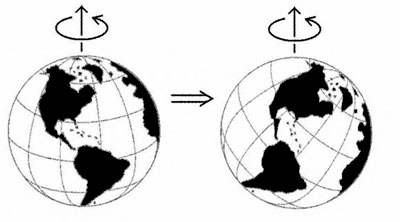|
October 01, 2012
to identify four possible instances of true polar wander in the past.
And, they say, true polar wander is
happening now.
Scientists based in Germany and Norway today published new results about a geophysical theory known as true polar wander. That is a drifting of Earth’s solid exterior - an actual change in latitude for some land masses - relative to our planet’s rotation axis.
These scientists used hotspots in Earth’s mantle as part of a computer model, which they say is accurate for the past 120 million years, to identify four possible instances of true polar wander in the past. And, they say, true polar wander is happening now.
These scientists published their results
in the Journal for Geophysical Research today (October 1,
2012).
Based on this reference frame, they say that twice - from 90 to 40 million years ago - the solid Earth traveled back and forth by nearly 9 degrees with respect to our planet’s axis of rotation.
What’s more, for the past 40 million
years, the Earth’s solid outer layers have been slowly rotating at a
rate of 0.2 degrees every million years, according to these
scientists.
Diagram showing solid-body rotation of the Earth with respect to a stationary spin axis due to true polar wander. This diagram is greatly exaggerated. According to Doubrovine and his team, Earth’s solid outer layers have been slowly rotating at a rate of
0.2 degrees every
million years. Diagram via Wikimedia Commons. True polar wander is not:
True polar wander is a geophysical theory, a way of thinking about Earth processes that might happen and that these scientists believe do happen.
The theory suggests that if an object of sufficient weight on Earth - for example, a supersized volcano or other weighty land mass - formed far from Earth’s equator, the force of Earth’s rotation would gradually pull the object away from the axis around which Earth spins. A supersized volcano far from Earth’s equator would create an imbalance, in other words.
As explained at Princeton.edu:
That’s the theory of true polar wander. It would cause a movement of Earth’s land masses, but for a different reason than the reason the continents drift in the theory of plate tectonics (formerly called “continental drift”).
In the theory of plate tectonics, the
continents drift because Earth’s the layer of Earth underlying our
planet’s crust, called the mantle, is convective. That is, it
circulates, slowly - like water about to boil. In true polar wander,
on the other hand, a similar-seeming movement of land masses on
Earth’s crust happens in order to correct an imbalance of weight
with respect to Earth’s spin.
Doubrovine and his team say they found
one: volcanic hotspots.
Hotspot forming an island chain.
As
land plates drift, a successive of volcanoes form over the hotspot. In geology, hotspots are volcanic regions fed by Earth’s underlying mantle.
For example, the Hawaiian islands are believed to have formed over a hotspot in the mantle. The hotspot created a volcano, but then - as that land plate drifted over time, as described by the theory of plate tectonics - the volcano drifted, too, and was eventually cut off from the hotspot.
Gradually, another volcano begins to form over the hotspot, right next to the first one. And then it moves on… and another one forms… and so on… and so on.
Earth’s crust produces first one, then
another volcano over the hotspot until a long chain of volcanoes
forms, such as in Hawaii. Hotspots have long been used to understand
the motion of tectonic plates.
According to these scientists, this
drifting is what produced a model of a stable reference frame, which
in turn let them draw conclusions about true polar wander. The Hawaiian islands are believed to have formed over a hotspot - a particularly hot place in Earth’s underlying mantle. Scientists expanded on previous thinking about hotspots to suggest that
Earth’s solid surface
is drifting, minutely, with respect to our planet’s rotation axis.
German and Norwegian scientists have incorporated hotspots in Earth’s mantle into a computer model being used to study true polar wander.
They say their work established a stable reference frame for this study that lets them conclude Earth is undergoing true polar wander today.
|



